|
Module 63 |
Updated: 08/30/2005 |
|
News and Part I
If there's a war, a disaster, or
a major civil disturbance somewhere in the world, television news will be there.
Electronic newsgathering or ENG technology makes us an eyewitness to Although the printed word can be powerful, as we've so often
seen in the last 50 years, seeing images, especially on TV, makes happenings
much more real. The Forum letter, At the same time, keep in mind that George Lucas, one of the most successful producers of all time, said, "It's very foolish to learn the how without the why." In news and documentary work the "why" is especially important, not only in understanding the process, but for your own professional success. During the events surrounding the September 11, 2001, terrorists attacks on the East Coast of the United States where about 2,000 people died, TV news brought the nation and much of the world together in feelings of outrage and sorrow. The same happened in July, 2005 after the London terrorists attacks.
The major news organizations now assemble a wide range of live video, audio reports, photography collections, animated weaponry displays, and interactive maps for Internet users. The chart below summarizes the relative popularity of the top Internet news sources. Relative Popularity of
Top Internet News Sources
Keep in mind that Internet use is positively related to education and age—the younger and better educated tend to use the Internet more. This explains part of the discrepancy between the news channel rankings listed above and the over-the-air TV news ratings. Note from the graph below
that when all age groups are However, among high-school and college-age youth the Internet is now the most relied upon source of news. At the same time, newspapers, which for many decades were
the main source of news for Americans,
Electronic newsgathering (ENG) is a part of electronic field production (EFP). Although in all-digital operations we're starting to see the initials DNG used for digital newsgathering, we'll stick to "ENG" for this discussion. Electronic Field Production (EFP) includes many other types of field productions, including commercials, music videos, on-location dramatic productions, and various types of sports coverage. EFP work generally provides the opportunity to insure maximum audio and video quality. In ENG work the primary goal is to get the story. In
90% of news work there will be time to insure audio and video quality, which is
what the news director and producer will expect. But conditions are not always ideal
in news work, and if compromises must be made they are made in audio and video quality,
not in story content. |
|
The most-watched and celebrated
television news story in history was shot with one low-resolution black-and-white
Although the quality of the footage was poor, no TV news editor said to NASA, "You've got some interesting footage there, NASA, but we'll have to pass; the quality just doesn't come up to our standards." In democratic society news and documentaries also serve an important "watchdog" function. Not only do they tend to keep politicians and other officials honest, but they have also brought to light countless illegal activities. Once such things become public knowledge, corrective action often follows.
We can more fully appreciate the power and influence of TV news when we consider the lengths to which some people and nations go to control it. As we have seen countless times, the news media are the first target for those who want to control the people of a country. South Africa and the Philippines are two examples that we've previously cited. Although censorship is often justified
as a way of protecting Today, there are many countries that censor-or at least try
to censor-broadcast news, Even with its First Amendment to the Constitution guaranteeing
free speech, the United States has a long history of censorship attempts.
Even though censorship is often associated with the political and religious right,
today, as noted in Although
broadcast news has There is no doubt that
Thus, stories that will grab and hold an audience are favored over those that in the long run may be much more consequential. Stories that are "visual" are favored over those that are static and more difficult to explain or understand. A baby beauty contest or a dog show may win out over coverage of a city council meeting or a international trade conference. Given the preferences of viewers who are constantly "voting" on program popularity with their TV remote controls, a news director (whose job largely depends on maximizing ratings and station profits) may have little choice but to appeal to popular tastes. As conglomeration
spreads with more and more media outlets being owned by several huge corporations,
news is emanating from fewer and fewer sources. Even now it's alleged that
At the same time, news is very competitive, and outlets that bypass or downplay certain stories because they may negatively impact advertising profits or corporate prestige, may find that their credibility drops with viewers. This route is unwise, if for no other reason, because it will eventually impact news ratings and, subsequently, profits. But, there is also this: Most people get most of their news from their favorite TV news station. If TV news bypasses certain stories because they may be unpopular with certain factions, the viewers may never know. (How can you miss something if you don't know about it in the first place?) Such issues are fueling considerable debate in the United States. This concern may also explain why greater numbers of people in the United States have been turning to British (BBC) and Canadian (CBC) network news programming (available by satellite), which they feel is less influenced by ratings, and political and corporate influences.
Today, most of what people know about the world, its peoples, and the critical social and political issues of the times, comes from TV. Those who produce TV news and documentaries collectively hold the keys to much power and influence.
The hard-hitting, hour-long documentaries, such as NBC's "Harvest of Shame," which won many awards and sparked social reform, have all but disappeared on commercial broadcast television. They have lost favor because they produce low ratings and are expensive and time-consuming to produce. Plus, they often step on the toes of influential individuals and corporations, and that can upset network sponsors and even spark lawsuits. In their place on the commercial networks are typically the softer, human interest mini-documentaries featured in some of the popular news magazines.
Before we dismiss the audience for documentaries as limited, we need to remember that a surprising number of documentaries have had mainstream appeal -- even to the point making an impact in movie box offices. Here is a list of the most popular documentaries in the last ten years and the revenue generated to late-2004. Even before its release on DVD, the controversial Fahrenheit 9/11, generated revenue comparable to popular mainstream films.
The quality of today's prosumer digital
video is good enough to be transferred to 35mm motion picture film and shown in
theaters. This means that for the fist time you can purchase a video camera at your
local electronics store with the hope of producing a professional documentary --
or, as we've also seen in some cases, even an
When handling controversial subject matter broadcast television is different from many of the films noted above because it must attempt to show balance. Although broadcasters no longer have a legal "equal time," mandate from the FCC, the airwaves still belong to the public. With the exception of religious views, which can legally go unchallenged, the FCC expects networks and stations to present opposing views - especially if they represent major factions. Not to do so can spark legal action and station license challenges. Plus, since "biased" is a word that you don't want to hear about your work (especially if you plan to stay employed), you don't want to promote your own view on an issue and not seek opposing views. Let me speak personally for a moment. As a person who spent many years in news (newspapers, radio, and TV) I had to confront this issue very early in my career. I can recall becoming upset and emotionally involved in stories involving the unfair or illegal treatment of people. Around the newsroom I was known to start sentences with, "We've got to do something about...."
He said. "Worry about your job and not somebody else's. Your job is simply to uncover the facts-as many as you can on both sides of the issue. The less emotionally involved you are the better you'll be able to do your job. Let the politicians, preachers, public officials, or whoever, do something about what you find out. That's their job." Part of your responsibility as a newsperson is to bring out the various sides of an issue. This means you allow each side to state their views as strongly and convincing as they can. Not only is it the professional thing to do, but it will also add interest and controversy to your news stories. If you keep an open mind right from the beginning, you may uncover facts that put issues in a whole new light. Again, speaking from many years of experience in news, I often found that my initial views on issues dramatically changed after I uncovered facts that were not commonly known. In speaking to potential spokespersons for TV news pieces you need to carefully explain the nature of the story. You also want to carefully document your attempts at finding opposing views. This will protect you both legally and professionally. In news pieces you have to rely on the telephone to set up interviews. If key people refuse comment or refuse to be interviewed, some producers send these people registered letters, so after the piece is aired they can't suddenly say they didn't understand what was going on, or that they were denied the opportunity to present their side. At the same time, keep in mind that when an issue is being litigated, an attorney might restrain them from commenting, a fact that should also be mentioned. In case you missed it in Module 55, the
basic do's and don'ts of interviewing can be
The number and type of positions involved in producing a daily newscast will vary from two or three people in a very small station to more than 100 in Toronto, New York, Los Angeles, or Tokyo.
Larger stations have segment producers in charge of specific stories or newscast segments. Some stations will have an executive producer who is over the producer(s). Two types of directors are involved in putting the newscast on the air. The news director is the top person in the News Department. This person controls the budget, hires and fires personnel, and has ultimate responsibility for the station's news. Much further down the ladder of responsibility is the on-air director for the newscast. This person's responsibility is to take the plans of the producer and "call the shots" in the on-air phase of the broadcast. As the title suggests, the ENG coordinator starts with the story assignments made by the assignment editor and works with reporters, ENG crews, editors, technicians, and the producer to see that the stories make it to "air." ENG coordinators must not only thoroughly know their studio and location equipment, but also understand news, which brings us to the...
Those involved in ENG work
must understand the factors that constitute news value, or newsworthiness. These
are explained
Ultimately,
the job of the journalist-especially the investigative journalist-is to Even when there seems to be a major injustice involved, it is not the responsibility of the reporter to "prove" that injustice, but simply to bring the related facts to the public's attention. In the case of complex stories and situations, this does not exclude the necessary interpretation of the facts. In mid-2002 two major stories were reported in the U.S. press: the molestation of hundreds of children by clergy and the largest corporate bankruptcy in U.S. history. In both cases the incriminating facts had been successfully hidden from the public as the situations continued to get progressively worse.
In both cases it was the journalist's job to uncover the facts that people were rather successfully hiding and bring these facts to the public's attention; in other words, to fulfill their role as "the watchdogs of a democratic society." Generally, public exposure is all that is needed to initiate corrective action.
Today, we
commonly see "one-man bands" in the covering of television In case you are wondering what the term "one-man band" refers to, it originally referred to a man who played multiple musical instruments at the same time. In the case of the person on the left, however, we have a one-woman band. In a slightly more modern interpretation, an on-camera reporter shoots the basic story, then sets up a camera on a tripod, focuses on a mark on the ground, tilts the camera up to his or her height and lock it, puts on a mic and checks the audio, rolls the recorder, and then standing on the mark delivers the opening and closing to the piece. Once back at the studio, the same person edits the piece and does the voice-over narration. (And now you know why it's important to know all aspects of TV production!) This has led to the term, video journalist (VJ), a single field reporter who writes, reports, shoots and edits stories alone. Not easy, but it saves hiring extra people. Thus, it's more essential than ever before that the entire news process and the associated pitfalls are understood.
Broadcast news is a highly competitive business and in the rush to get a story on the air it's sometimes tempting to guess at facts or depend on unreliable sources. However, errors in stories not only damage a station's credibility, but they can derail a reporter's professional future. Here are five points to keep in mind when writing news stories.
Once reporters turn in their stories and a news producer or director takes over, many decisions must still be made before the stories are ready for broadcast. Among other things, the stories must be reviewed for balance, lead-ins (story introductions) must be written, and appropriate graphics must be prepared to support the stories. Here are five points that should be considered before the newscast goes on the air.
You may recall that in Module 55 we discussed some important considerations in editing news pieces.
Conservatives think that TV news has a liberal bias and liberals feel that news has a conservative bias. Being a human endeavor, total objectively in news is impossible, of course. When you analyze bias complaints you are apt to conclude that bias is defined as "any view that differs from mine." Although the media is Bias can stem just as much from what TV news reports as what it doesn't report. When it comes to politics, great effort goes into trying to keep certain things from becoming public. It has been well documented that many embarrassing government documents that have nothing to do with national security are marked "classified" to keep the information from the public.
At Times, A Dangerous Profession In the United States, as elsewhere, reporters have been killed before their stories could be aired. Numerous books and articles document this. Although some of these authors might be seen as "conspiracy theorists," the death of journalists and scores of informants on the eve of important revelations, can't all be viewed as coincidence. According to the Committee to Protect Journalists, between 1992 and 2001, 399 journalists were killed "because of their work." In 2004, 55 journalists were killed while covering stories. Suffice it to say, investigating and breaking important stories often carries a degree of professional and personal risk. At the same time, this is the way awards are won and professional careers are advanced-and, far more importantly, wrongs are rectified and needed social change is instituted. |
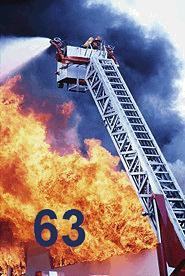
 happenings.
happenings.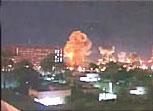 It
was during these times, another application of video moved into
prominence in news-the Internet.
It
was during these times, another application of video moved into
prominence in news-the Internet.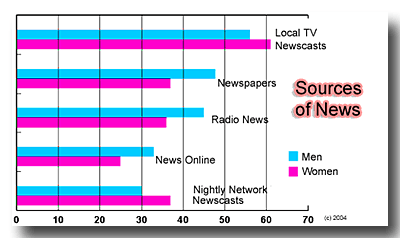 lumped
together TV news (local plus network) comprise the most popular source of
news in the United States.
lumped
together TV news (local plus network) comprise the most popular source of
news in the United States. video
camera, not the quality of video that you would think would make it to every major
TV network in the world. The video was of mankind's first steps on the moon.
video
camera, not the quality of video that you would think would make it to every major
TV network in the world. The video was of mankind's first steps on the moon. most of TV news in the United States-especially at the network level-is ratings
driven.
most of TV news in the United States-especially at the network level-is ratings
driven.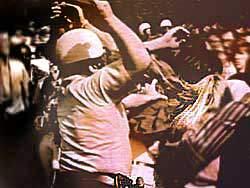 When
a seasoned journalist saw what was happening (and that it was affecting my objectivity)
he passed on some advice that helped me over the years.
When
a seasoned journalist saw what was happening (and that it was affecting my objectivity)
he passed on some advice that helped me over the years.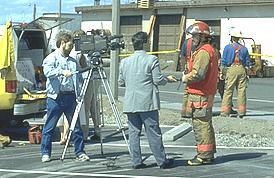 Although
responsibilities and titles can vary among stations, generally the news
producer is the person who is directly in charge of the newscast. He or she
makes the major minute-by-minute decisions on both the technical and content aspects
of the newscast.
Although
responsibilities and titles can vary among stations, generally the news
producer is the person who is directly in charge of the newscast. He or she
makes the major minute-by-minute decisions on both the technical and content aspects
of the newscast. uncover
the truth about situations and explain that truth in a clear and succinct manner.
uncover
the truth about situations and explain that truth in a clear and succinct manner.
 Had
the truth been uncovered and publicized earlier, something could have been
done to head off the pain and suffering that a great many people had
to subsequently
endure—as, for example, the many additional children who were molested
and the scores of people who lost all of their retirement funds while
some
corporate
executives pocketed
millions of dollars.
Had
the truth been uncovered and publicized earlier, something could have been
done to head off the pain and suffering that a great many people had
to subsequently
endure—as, for example, the many additional children who were molested
and the scores of people who lost all of their retirement funds while
some
corporate
executives pocketed
millions of dollars. news; i.e., one person doing everything: camera operator, reporter, sound person,
and editor.
news; i.e., one person doing everything: camera operator, reporter, sound person,
and editor. To
help address this issue The Freedom of Information Act
was passed that allows citizens and reporters access to some government documents.
Although the process of obtaining documents can be fraught with red tape and delays,
and key information is often blacked out, passage of The Freedom of Information
Act represented a major step forward for investigative journalism.
To
help address this issue The Freedom of Information Act
was passed that allows citizens and reporters access to some government documents.
Although the process of obtaining documents can be fraught with red tape and delays,
and key information is often blacked out, passage of The Freedom of Information
Act represented a major step forward for investigative journalism.